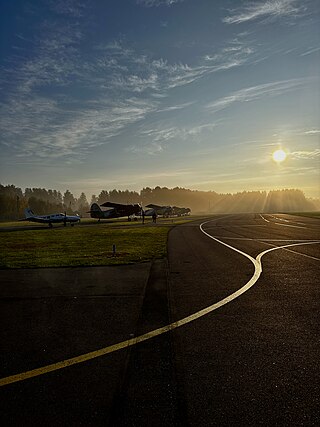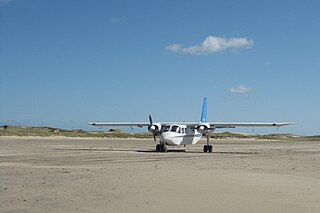
An aerodrome or airfield is a location from which aircraft flight operations take place, regardless of whether they involve air cargo, passengers, or neither, and regardless of whether it is for public or private use. Aerodromes include small general aviation airfields, large commercial airports, and military air bases.

Brockville Regional Tackaberry Airport, also known as Brockville Municipal Airport, is a registered aerodrome located in Elizabethtown-Kitley Township, 4.8 nautical miles northwest of the city of Brockville, Ontario, Canada.

Pendleton Airport is located 3 nautical miles northwest of Pendleton, Ontario, Canada, east of Ottawa. The airfield is currently operated by the Gatineau Gliding Club.
Snare River Airport is a private aerodrome in the Northwest Territories, Canada near the Snare River. Caribou may be found on the runway. Prior permission is required to land except in the case of an emergency.
Billy Bishop Toronto City Water Aerodrome is located in Toronto Harbour, Toronto, Ontario, Canada, adjacent to Billy Bishop Toronto City Airport on the Toronto Islands. Closed briefly in 2005, the aerodrome provides the only facility for floatplanes in the city. The aerodrome is classified as an airport of entry by Nav Canada and is staffed by the Canada Border Services Agency (CBSA). CBSA officers at this airport can handle general aviation aircraft only, with no more than 15 passengers.
Collingwood Airport is a medium-sized registered aerodrome located 4 nautical miles southeast of Collingwood, Ontario, Canada, 45 km (28 mi) west of Barrie and 150 km (93 mi) north of Toronto. It is located in the township of Clearview, near Wasaga Beach and the ski hills of Blue Mountain.

Saint-Hyacinthe Aerodrome is located 3 nautical miles west of Saint-Hyacinthe, Quebec, Canada.
Gananoque Airport is located 4.3 nautical miles northwest of the town of Gananoque, Ontario, Canada, in Canada's busy Quebec City-Windsor Corridor. It is currently a major centre for skydiving, as well as one of the three Canadian airports serving the Thousand Islands.

Guelph AirPark also known as Guelph Airport or Guelph Airfield is located in the southeastern part of Guelph/Eramosa at its border with Guelph in Ontario, Canada. It consists of two runways, 14/32 and 06/24. Although known to residents as the "Guelph Airport" or "Guelph AirPark", it is actually an aerodrome, being registered, and not certified, by Transport Canada.
Rockton Aerodrome is located in Flamborough, Ontario 1.5 nautical miles west of Rockton, Ontario, Canada.
Calgary/Okotoks Airranch Airport is located 15 nautical miles south of Calgary, Alberta, Canada. The airport is home to Access Helicopters, Foothills Helicopter Training Academy, and many privately owned aircraft. The certified airport welcomes itinerant aircraft and asks pilots to call for PPR.

Coronach/Scobey Border Station Airport is located 8 nautical miles southeast of Coronach, Saskatchewan, Canada and 13 mi (21 km) north of Scobey, Montana, United States. In the United States, the airport is known by the names Scobey Border Station Airport and East Poplar International Airport. It is owned by the U.S. and Canadian governments.
North Battleford/Hamlin Airport(TC LID: CJD4) was located 1 nautical mile north-east of Hamlin, Saskatchewan, Canada, in the RM of North Battleford No. 437.
Quamichan Lake Airport is located 2.7 nautical miles north northeast of Duncan, adjacent to Quamichan Lake, British Columbia, Canada.

Markham Airport or Toronto/Markham Airport is a private aerodrome operating 2.6 nautical miles north of Markham, Ontario, Canada near Toronto.

Sable Aviation is an on-demand aircraft charter company operating from the Gateway Facilities hangar/FBO at the Halifax Stanfield International Airport whose primary role is to provide fixed wing service to Sable Island.










